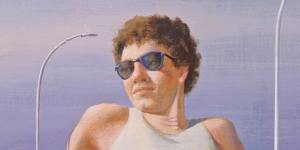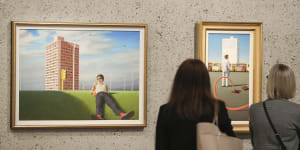To Smart,it was clear that Adelaide,his hometown,would never give his work a chance. And equally clear the curators in Canberra,and elsewhere in Australia,had it in for him. Was it just paranoia? Sour grapes? Smart felt he was paying the penalty for swimming against the tide. He had no interest in the Australiana associated with artists such as Nolan,Boyd,Tucker and Olsen. He had no sympathy for the tides of abstract and conceptual art that dominated the 1960s and ’70s.

NGA director Nick Mitzevich with two works in the Jeffrey Smart exhibition on December 10.Alex Ellinghausen
Resolutely figurative,he was a painter of the modern,urban world,not the bush or the mythical past. A typical Smart painting could have been set in Italy (where he lived for more than 40 years) or Australia. His images were cool and oblique,devoid of obvious emotion. The art institutions may have found him old-fashioned and reactionary,but the public has always adored his work.
Jeffrey Smart,which starts this weekend at the National Gallery of Australia,as it is now known,is a show that might have won the artist’s approval. Hung thematically rather than chronologically (which seems to be the case with the entire NGA at present),it’s not a comprehensive retrospective. It is,however,a better,more thoughtful display than the highly successful Smart survey held at the Art Gallery of NSW in 1999. Even allowing for COVID-19 travel restrictions,the NGA should have a hit on its hands.
Although he may have struggled to impress the curators,Smart has always had dedicated admirers. His work has become part of Australia’s popular culture,partly due to its frequent appearance on book covers. Once seen,his pictures are rarely forgotten,and the chance to view more than 90 of his paintings will provide an excellent reason to visit Canberra over the summer.
The dominant impression one takes away from this show is how amazingly fresh it looks. Eight years after his death,at the age of 93,Smart comes across as an artist who broke free of the relentless succession of schools,fashions and movements that characterise the modern era.

Jeffrey Smart,North Sydney,1978.Collection of Will and Jane Vicars
He was,superficially,a realist,but after a few minutes in this exhibition that label seems pitifully inadequate. From the earliest paintings such asThe Salvagers (1946) orRobe(1947),Smart was looking for something different,seeking out a classical beauty in piles of junk and debris. It was a self-conscious repudiation of those picturesque vistas of sheep and gum trees that passed for respectable Australian art. It also signalled an emphasis on composition that would only grow more obsessive over the years.
Looking at these paintings,it’s easy to see how much thought has gone into every tiny detail. Nothing is left to chance in Smart’s pictures:shapes and forms are repeated in many different guises;textures and colours are carefully chosen. InThe Dome (1977),a red-and-white stick set at a jaunty angle is compositionally no less important than the looming form of St. Peter’s Basilica.
In pictures such asThe Traveller (1973),the play of lines,planes and reflections is bewildering in its complexity,but grounded in a precise geometrical design. This exactitude was built on a study of Old Masters such as Piero della Francesca,but Smart’s subject matter was utterly contemporary.
His favourite motifs are trucks,buses,lorries,television towers,highways,traffic signs and rows of concrete apartments blocks. He defies us not to find these things beautiful,refuting the banal idea that everything natural is pleasing to the eye while the man-made world is a study in grim alienation.

Guests admiring some of Smart’s artworks on display at the National Gallery of Australia.Alex Ellinghausen
Smart’s paintings are full of epiphanies,such as the girl in a pink dress running in front of a green barricade inThe Construction Fence(1978),or the outlandish red radar dish towering over the suburban skyline inRooftops (1968-69). He startles us into a sudden awareness of just how strange and marvellous the world can be.
His paintings have often been compared to film stills but we never get to see the rest of the movie. He presents us with small,truncated fragments torn from the fabric of life,that we experience as enigmas. This,perhaps,is why Smart’s paintings have such lingering appeal,becoming more intriguing with each viewing. In these precisely painted windows onto the world,we feel everything is clear and legible. Keep looking,and nothing is quite what it seems.
Jeffrey Smart,National Gallery of Australia,Canberra,until May 15,2022. Book tickets at.
Find out the next TV,streaming series and movies to add to your must-sees..